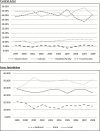Media Portrayal of the Nursing Homes Sector: A Longitudinal Analysis of 51 U.S. Newspapers
- PMID: 26884064
- PMCID: PMC6075026
- DOI: 10.1093/geront/gnv684
Media Portrayal of the Nursing Homes Sector: A Longitudinal Analysis of 51 U.S. Newspapers
Abstract
Purpose: Most Americans' low opinion of the nursing home (NH) sector could derive, in part, from the way in which it is portrayed in the media. This study furthers understanding of media portrayal of the NH sector by identifying how NHs were depicted in 51U.S. newspapers from 1999 to 2008.
Design and methods: Keyword searches of the LexisNexis database were performed to identify 16,280 NH-related articles. Article content was analyzed, and tone, themes, prominence, and central actor were assessed. Basic frequencies and descriptive statistics were used to examine article content across regions, market type, and over time.
Results: Findings reveal considerably less NH coverage in the Western United States and a steady decline in NH coverage nationally over time. Most articles were news stories; more than one third were located on the front page of the newspaper or section. Most articles focused on NH industry and government interests, very few on residents/family and community concerns. Most articles were neutral or negative in tone; very few were positive or mixed. Common themes included quality, financing, and legal concerns. Tone, themes, and other article attributes varied across region, market type, and over time.
Implications: Overall, findings reveal changes in how newspapers framed NH coverage, not only with respect to tone but also with respect to what dimensions of this complex issue have been emphasized during the time period analyzed. Variation in media coverage may contribute to differences in government and public views toward the NH sector across regions and over time.
Keywords: Agenda setting; Content analysis; Long-term care; Nursing facilities.
© The Author 2016. Published by Oxford University Press on behalf of The Gerontological Society of America. All rights reserved. For permissions, please e-mail: journals.permissions@oup.com.
Figures
Similar articles
-
Thrust Into the Spotlight: COVID-19 Focuses Media Attention on Nursing Homes.J Gerontol B Psychol Sci Soc Sci. 2021 Mar 14;76(4):e213-e218. doi: 10.1093/geronb/gbaa103. J Gerontol B Psychol Sci Soc Sci. 2021. PMID: 32696957 Free PMC article.
-
National newspaper portrayal of U.S. nursing homes: periodic treatment of topic and tone.Milbank Q. 2012 Dec;90(4):725-61. doi: 10.1111/j.1468-0009.2012.00681.x. Milbank Q. 2012. PMID: 23216429 Free PMC article.
-
National newspaper portrayal of nursing homes: tone of coverage and its correlates.Med Care. 2013 Jan;51(1):78-83. doi: 10.1097/MLR.0b013e318270baf2. Med Care. 2013. PMID: 23032355 Free PMC article.
-
How the public perceives the "good nurse" in China: A content analysis of national newspapers.J Nurs Scholarsh. 2024 Jan;56(1):164-173. doi: 10.1111/jnu.12928. Epub 2023 Aug 22. J Nurs Scholarsh. 2024. PMID: 37608546 Review.
-
How Do Nigerian Newspapers Report Corruption in the Health System?Int J Health Policy Manag. 2021 Feb 1;10(2):77-85. doi: 10.34172/ijhpm.2020.37. Int J Health Policy Manag. 2021. PMID: 32610718 Free PMC article. Review.
Cited by
-
Thrust Into the Spotlight: COVID-19 Focuses Media Attention on Nursing Homes.J Gerontol B Psychol Sci Soc Sci. 2021 Mar 14;76(4):e213-e218. doi: 10.1093/geronb/gbaa103. J Gerontol B Psychol Sci Soc Sci. 2021. PMID: 32696957 Free PMC article.
-
"Where it's okay if we die": Exploring Older Canadians' Perspective on Long-Term Care Through Found Poetry.Gerontologist. 2025 May 10;65(6):gnaf040. doi: 10.1093/geront/gnaf040. Gerontologist. 2025. PMID: 39932734 Free PMC article.
-
What's Keeping Residents "Out of the Mainstream": Challenges to Participation in the News Media for Older People Living in Residential Care.J Appl Gerontol. 2023 Jun;42(6):1313-1323. doi: 10.1177/07334648221143619. Epub 2022 Dec 4. J Appl Gerontol. 2023. PMID: 36464915 Free PMC article.
-
Influence of Sociodemographic, Organizational, and Social Factors on Turnover Consideration Among Eldercare Workers: A Quantitative Survey.Int J Environ Res Public Health. 2023 Aug 20;20(16):6612. doi: 10.3390/ijerph20166612. Int J Environ Res Public Health. 2023. PMID: 37623196 Free PMC article.
-
Media depictions of primary care teleconsultation safety: a thematic analysis of UK newspapers.Br J Gen Pract. 2024 Sep 26;74(747):e695-e701. doi: 10.3399/BJGP.2023.0543. Print 2024 Oct. Br J Gen Pract. 2024. PMID: 38621808 Free PMC article.
References
-
- Audit Bureau of Circulations. (2010). Circulation averages for the six months ended Retrieved September 30, 2010, from http://abcas3.accessabc.com/ecirc/newstitlesearchus.asp
-
- Barnes M. D. Hanson C. L. Novilla L. M. B. Meacham A. T. McIntyre E., & Erickson B. C (2008). Analysis of media agenda setting during and after Hurricane Katrina: Implications for emergency preparedness, disaster response, and disaster policy. American Journal of Public Health, 98, 604–610. doi:10.2105/AJPH.2007.112235 - PMC - PubMed
-
- Barry C. L. Jarlenski M. Grob R. Schlesinger M., & Gollust S. E (2011). News media framing of childhood obesity in the United States from 2000 to 2009. Pediatrics, 128, 132–145. doi:10.1542/peds.2010–3924 - PubMed
-
- Baumgartner F., & Jones B. D (1993). Agendas and instability in American politics. Chicago: The University of Chicago Press.
-
- Bonafont L. C., & Baumgartner F. R (2013). Newspaper attention and policy activities in Spain. Journal of Public Policy, 33, 65–88. doi:10.1017/S0143814X12000219
Publication types
MeSH terms
Grants and funding
LinkOut - more resources
Full Text Sources
Other Literature Sources
Medical




